Adaptive Stochastic GERT Modeling of UAV Video Transmission for Urban Monitoring Systems
Abstract
1. Introduction
1.1. Motivation
1.2. State of the Art
1.3. Objectives and Contribution
- To substantiate the expediency of using GERT as a method for describing the data transmission process with probabilistic branches and stochastic delays.
- To build the structure of a GERT graph that reflects the key stages of processing, buffering, transmission, reception, and decoding of the video frame;
- To develop a mathematical model that takes into account the possibility of conditional selection of the transmission strategy of the frame depending on the risk assessment of loss, formalizes stochastic feedback for modeling retransmission of the frame in case of its untimely reception or loss, and forms analytical expressions for the moment-generating function of the system;
- To carry out numerical evaluation of QoS indicators and perform spectral analysis of the characteristic function.
- –
- the process of video frame transmission can be represented as a directed graph with deterministic and stochastic arcs;
- –
- the delay distributions at individual stages have triangular, exponential, or lognormal form, according to the characteristics of the corresponding technical operations;
- –
- the risk level assessment of frame loss is carried out by an external or embedded module (for example, based on machine learning), but the module itself is not modeled, and the result of its operation is taken into account as a condition for selecting the transmission strategy;
- –
- the probability of frame retransmission depends on the probability of non-delivery in the main branch and is implemented as stochastic feedback.
2. Materials and Methods
2.1. Justification for the Choice of GERT as a Means of Describing the Stochastic Process of Video Data Transmission from Onboard UAVs
2.2. General Architecture of the GERT Model for Video Data Transmission from Onboard UAVs
2.3. Construction of and Reduction in the GERT Model of Video Transmission in the UAV Network
- –
- deterministic delays—for stable hardware operations;
- –
- triangular—for buffering;
- –
- exponential—for radio transmission;
- –
- lognormal—for decoding and output;
- –
- geometric loops—for stochastic feedback.
- Pk is the transfer function of the k-th path from start to finish without loops,
- Δ is the system determinant accounting for all cycles (in our case, Δ =1 − L1);
- L1 is the only retransmission loop: ;
- Δk = 1, since Pk does not intersect with the loop.
3. Results
3.1. Simulation Setup and Parameterization
- –
- triangular distribution: a = 2, b = 6, c = 4;
- –
- exponential distribution: λ = 0.6;
- –
- lognormal distribution: μ = [3.0; 3.3; 3.5], σ = [0.7; 0.8; 0.9];
- –
- path probabilities: Plow = 0.6, Pmed = 0.3, Phigh = 0.1;
- –
- feedback parameters: Ploop = 0.05, tloop = 0.05 microseconds (μs).
- –
- frequency range: ;
- –
- frequency grid step: ;
- –
- smoothing parameter: ;
- –
- time interval: with step ms.
3.2. Results of the Numerical Experiment
3.3. Results of Comparative Study of the Developed Mathematical Model of Video Transmission from UAVs for Urban Monitoring Systems
4. Discussion
5. Conclusions
Author Contributions
Funding
Institutional Review Board Statement
Informed Consent Statement
Data Availability Statement
Conflicts of Interest
References
- Kabashkin, I.; Kulmurzina, A.; Nadimov, B.; Tlepiyeva, G.; Sansyzbayeva, Z.; Sultanov, T. Synchronized Multi-Point UAV-Based Traffic Monitoring for Urban Infrastructure Decision Support. Drones 2025, 9, 370. [Google Scholar] [CrossRef]
- Villarino, A.; Valenzuela, H.; Antón, N.; Domínguez, M.; Méndez Cubillos, X.C. UAV Applications for Monitoring and Management of Civil Infrastructures. Infrastructures 2025, 10, 106. [Google Scholar] [CrossRef]
- Xiao, X.; Wang, W.; Chen, T.; Cao, Y.; Jiang, T.; Zhang, Q. Sensor-Augmented Neural Adaptive Bitrate Video Streaming on UAVs. IEEE Trans. Multimed. 2020, 22, 1567–1576. [Google Scholar] [CrossRef]
- Abro, G.E.M.; Zulkifli, S.A.B.M.; Masood, R.J.; Asirvadam, V.S.; Laouiti, A. Comprehensive Review of UAV Detection, Security, and Communication Advancements to Prevent Threats. Drones 2022, 6, 284. [Google Scholar] [CrossRef]
- Meleshko, Y.; Raskin, L.; Semenov, S.; Sira, O. Methodology of probabilistic analysis of state dynamics of multidimensional semiMarkov dynamic systems. East.-Eur. J. Enterp. Technol. 2019, 6, 6–13. [Google Scholar] [CrossRef]
- Su, Y.; Wang, S.; Cheng, Q.; Qiu, Y. Buffer evaluation model and scheduling strategy for video streaming services in 5G-powered drone using machine learning. J. Image Video Proc. 2021, 2021, 29. [Google Scholar] [CrossRef]
- Frye, A. Modeling and Simulation of Vehicle Performance in a UAV Swarm Using Horizon Simulation Framework. Master’s Thesis, California Polytechnic State University, San Luis Obispo, CA, USA, 2018. [Google Scholar] [CrossRef]
- Galkin, B.; Kibiłda, J.; DaSilva, L.A. A Stochastic Model for UAV Networks Positioned Above Demand Hotspots in Urban Environments. IEEE Trans. Veh. Technol. 2019, 68, 6985–6996. [Google Scholar] [CrossRef]
- Tabet, T.; Knopp, R. Cross-Layer Based Analysis of Multi-Hop Wireless Networks. IEEE Trans. Commun. 2010, 58, 2067–2076. [Google Scholar] [CrossRef]
- Hong-qi, L.; Fang, Z.; Yuan, C.; Liangyan, T. “Inverse Problem” Model of GERT Network and Its Application in Complex Equipment Development Project Schedule Planning. In Proceedings of the 2013 IEEE International Conference on Grey systems and Intelligent Services (GSIS), Macao, China, 15–17 November 2013; pp. 384–390. [Google Scholar] [CrossRef]
- Semenov, S.; Kolisnyk, T.; Oksana, S.; Roh, V. Intelligent Extraction of the Informative Features for UAV Motion Modelling: Principles and Techniques. In Proceedings of the 2023 13th International Conference on Dependable Systems, Services and Technologies (DESSERT), Athens, Greece, 22–24 September 2023; pp. 1–6. [Google Scholar] [CrossRef]
- Zhang, N.; Ou, M.; Liu, B.; Liu, J. A GERT Network Model for input-output optimization of general aviation industry chain based on value flow. Comput. Ind. Eng. 2023, 176, 108945. [Google Scholar] [CrossRef]
- Khan, M.R.; Premkumar, G.R.V.; Van Scoy, B. Robust UAV-Oriented Wireless Communications via Multi-Agent Deep Reinforcement Learning to Optimize User Coverage. Drones 2025, 9, 321. [Google Scholar] [CrossRef]
- Semenov, S.; Krupska-Klimczak, M.; Wasiuta, O.; Krzaczek, B.; Mieczkowski, P.; Głowacki, L.; Yu, J.; He, J.; Chernykh, O. Intelligent Assurance of Resilient UAV Navigation Under Visual Data Deficiency for Sustainable Development of Smart Regions. Sustainability 2025, 17, 6030. [Google Scholar] [CrossRef]
- Mo, Y.; Huang, J.; Qian, G. Deep Learning Approach to UAV Detection and Classification by Using Compressively Sensed RF Signal. Sensors 2022, 22, 3072. [Google Scholar] [CrossRef] [PubMed]
- Bogyrbayeva, A.; Dauletbayev, B.; Meraliyev, M. Reinforcement Learning for Efficient Drone-Assisted Vehicle Routing. Appl. Sci. 2025, 15, 2007. [Google Scholar] [CrossRef]
- Zhou, L.; Yin, H.; Zhao, H.; Wei, J.; Hu, D.; Leung, V.C.M. A Comprehensive Survey of Artificial Intelligence Applications in UAV-Enabled Wireless Networks. Digit. Commun. Netw. 2024, in press. [CrossRef]
- Semenov, S.; Jian, Y.; Jiang, H.; Chernykh, O.; Binkovska, A. MATHEMATICAL MODEL OF INTELLIGENT UAV FLIGHT PATH PLANNING. Adv. Inf. Syst. 2025, 9, 49–61. [Google Scholar] [CrossRef]
- Aouladhadj, D.; Kpre, E.; Deniau, V.; Kharchouf, A.; Gransart, C.; Gaquière, C. Drone Detection and Tracking Using RF Identification Signals. Sensors 2023, 23, 7650. [Google Scholar] [CrossRef]
- Cwalina, K.K.; Rajchowski, P.; Sadowski, J. Lightweight Detection of Inserted Chirp Symbols in Radio Transmission from Commercial UAVs. Sensors 2025, 25, 4552. [Google Scholar] [CrossRef]
- Kim, D.-H.; Go, Y.-G.; Choi, S.-M. An Aerial Mixed-Reality Environment for First-Person-View Drone Flying. Appl. Sci. 2020, 10, 5436. [Google Scholar] [CrossRef]
- Jeng, S.-L.; Roy, R.; Chieng, W.-H. A Matrix Approach for Analyzing Signal Flow Graph. Information 2020, 11, 562. [Google Scholar] [CrossRef]
- Masud, M.; Shimi, F.N.; Gope, R.C. Numerical Integration Techniques: A Comprehensive Review. Int. J. Innov. Sci. Res. Technol. (IJISRT) 2024, 9, 2744–2755. [Google Scholar] [CrossRef]
- Shiri, B. Well-Posedness of the Mild Solutions for Incommensurate Systems of Delay Fractional Differential Equations. Fractal Fract. 2025, 9, 60. [Google Scholar] [CrossRef]
- Semenov, S.; Zhang, L.; Cao, W.; Bulba, S.; Babenko, V.; Davydov, V. Development of a fuzzy GERT-model for investigating common software vulnerabilities. East.-Eur. J. Enterp. Technol. 2021, 6, 6–18. [Google Scholar] [CrossRef]
- Witkovský, V. Numerical inversion of a characteristic function: An alternative tool to form the probability distribution of output quantity in linear measurement models. Acta IMEKO 2015, 5, 32–44. [Google Scholar] [CrossRef]
- Mijanović, A.; Popović, B.V.; Witkovský, V. A numerical inversion of the bivariate characteristic function. Appl. Math. Comput. 2023, 443, 127807. [Google Scholar] [CrossRef]
- Nouriani, H.; Ezzati, R. Application of Simpson quadrature rule and iterative method for solving nonlinear fuzzy delay integral equations. Fuzzy Sets Syst. 2020, 400, 147–161. [Google Scholar] [CrossRef]
- Chouhan, V.; Ray, S. Approximation Using Lagrange and Hermite Form of Polynomial Interpolation: An Experimental Study. In Proceedings of the 2021 International Conference on Advances in Electrical, Computing, Communication and Sustainable Technologies (ICAECT), Bhilai, India, 19–20 February 2021; pp. 1–6. [Google Scholar] [CrossRef]
- Mahtabi, M.J.; Ghasemi, A.; Ghasemi, A.; Newman, J.C., III. Polynomial Approximation over Arbitrary Shape Domains. Math. Comput. Appl. 2024, 29, 110. [Google Scholar] [CrossRef]
- Lee, W. Enabling Reliable UAV Control by Utilizing Multiple Protocols and Paths for Transmitting Duplicated Control Packets. Sensors 2021, 21, 3295. [Google Scholar] [CrossRef]
- Singh, P. A Contribution to Communication Management in Private Unmanned Aerial Vehicle Networks. Ph.D. Thesis, Central Queensland University, Rockhampton, Australia, 2020. [Google Scholar] [CrossRef]
- Smolyanskiy, N.; Gonzalez-Franco, M. Stereoscopic First-Person View System for Drone Navigation. Front. Robot. AI 2017, 4, 11. [Google Scholar] [CrossRef]
- Pratama, D.; Moon, J.; Laksmono, A.M.A.; Yun, D.; Iqbal, M.; Jeong, B.; Ji, J.H.; Kim, H. Behind The Wings: The Case of Reverse Engineering and Drone Hijacking in DJI Enhanced Wi-Fi Protocol. In Proceedings of the 2024 International Conference on Platform Technology and Service (PlatCon), Jeju, Republic of Korea, 26–28 August 2024; pp. 127–132. [Google Scholar] [CrossRef]
- Kushvaha, B.; Das, D.; Tamuli, A.; Bora, D.; Deka, M.; Choudhury, A. Modeling and Estimation of Traffic Intensity in M/M/1 Queueing System with Balking: Classical and Bayesian Approaches. AppliedMath 2025, 5, 19. [Google Scholar] [CrossRef]
- Feng, Y.; Xu, W.; Zhang, Z.; Wang, F. Continuous Hidden Markov Model Based Spectrum Sensing with Estimated SNR for Cognitive UAV Networks. Sensors 2022, 22, 2620. [Google Scholar] [CrossRef] [PubMed]
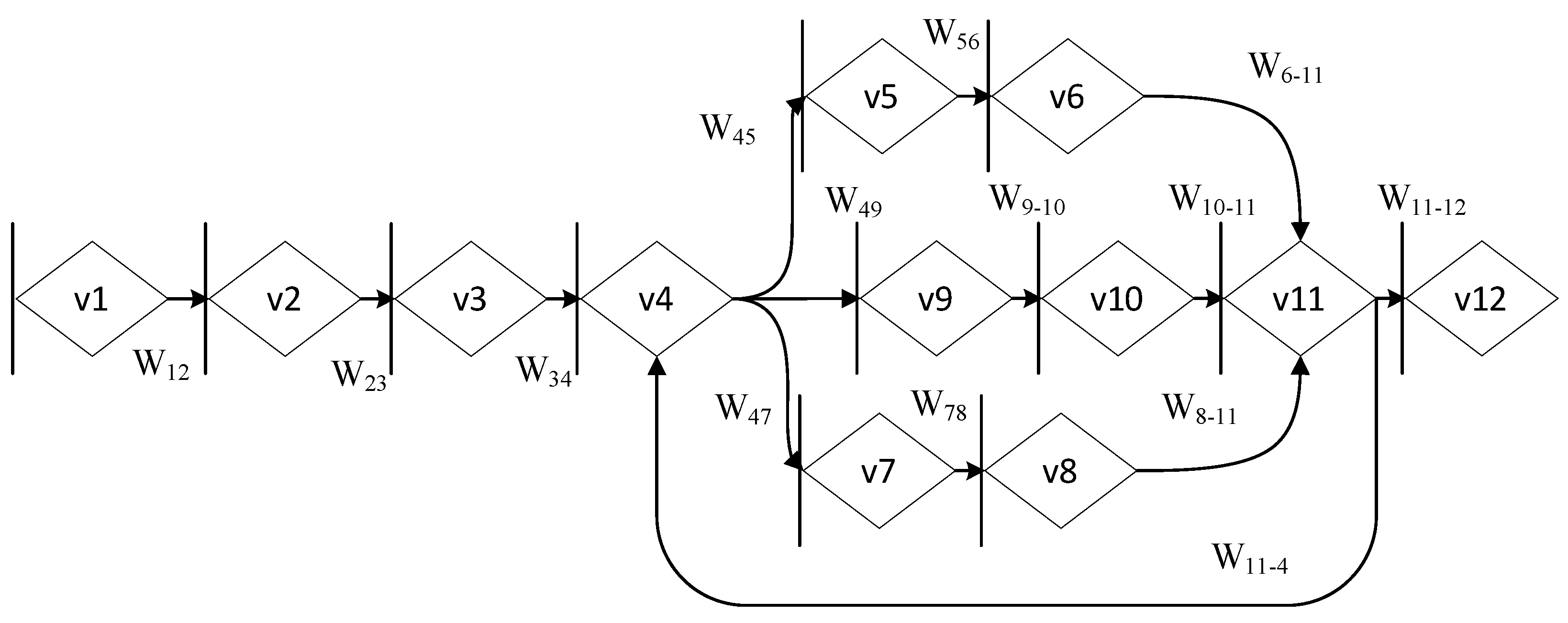

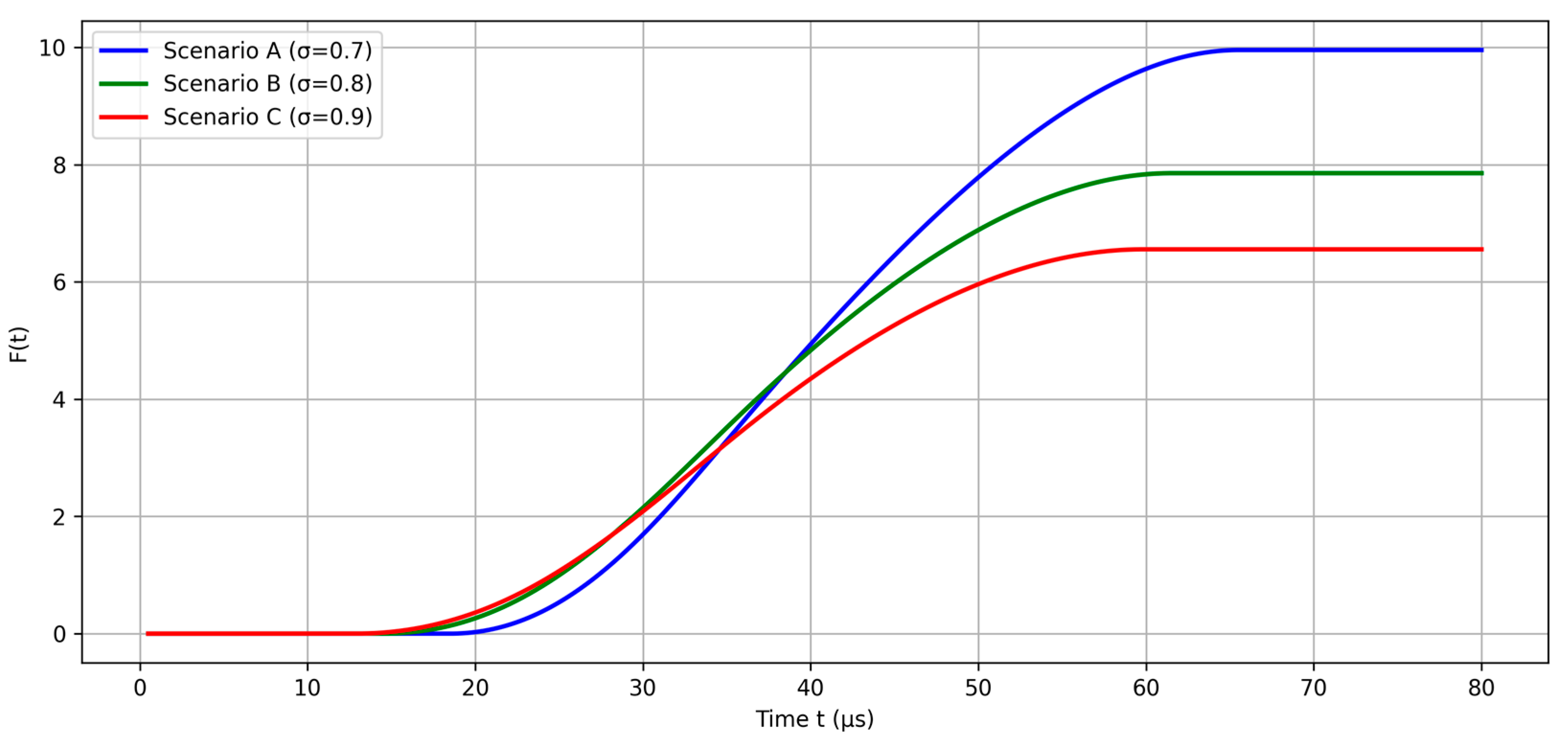
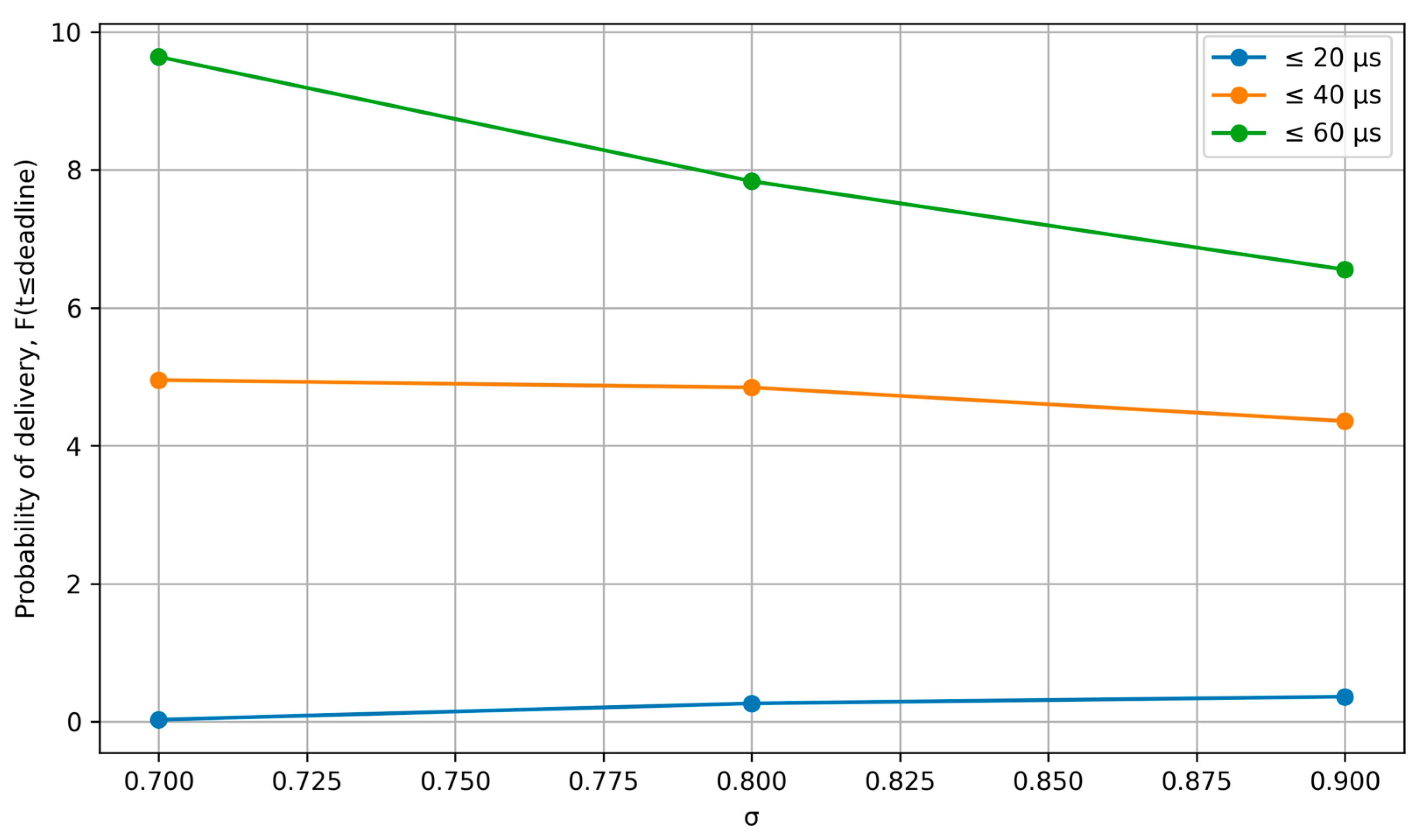
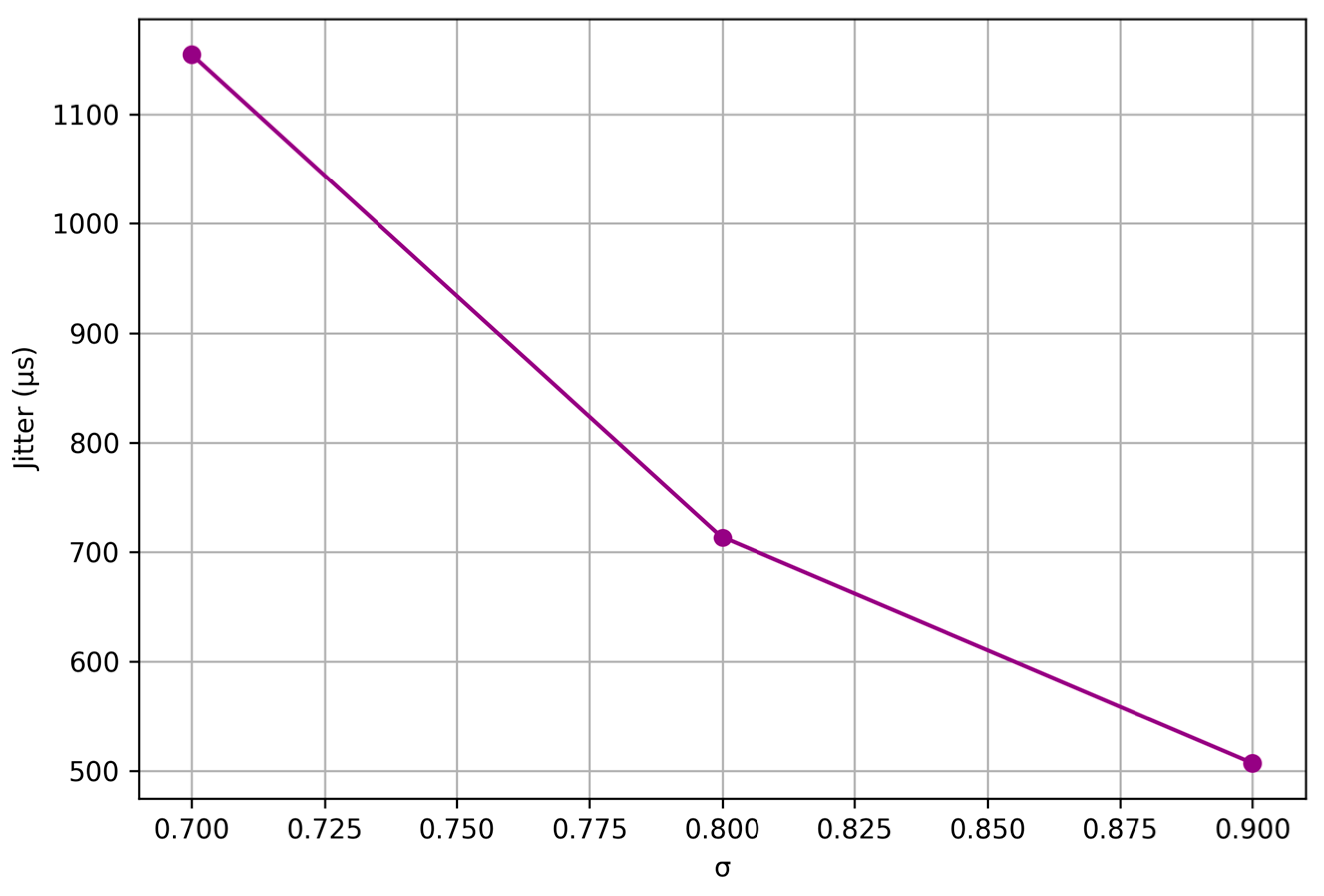
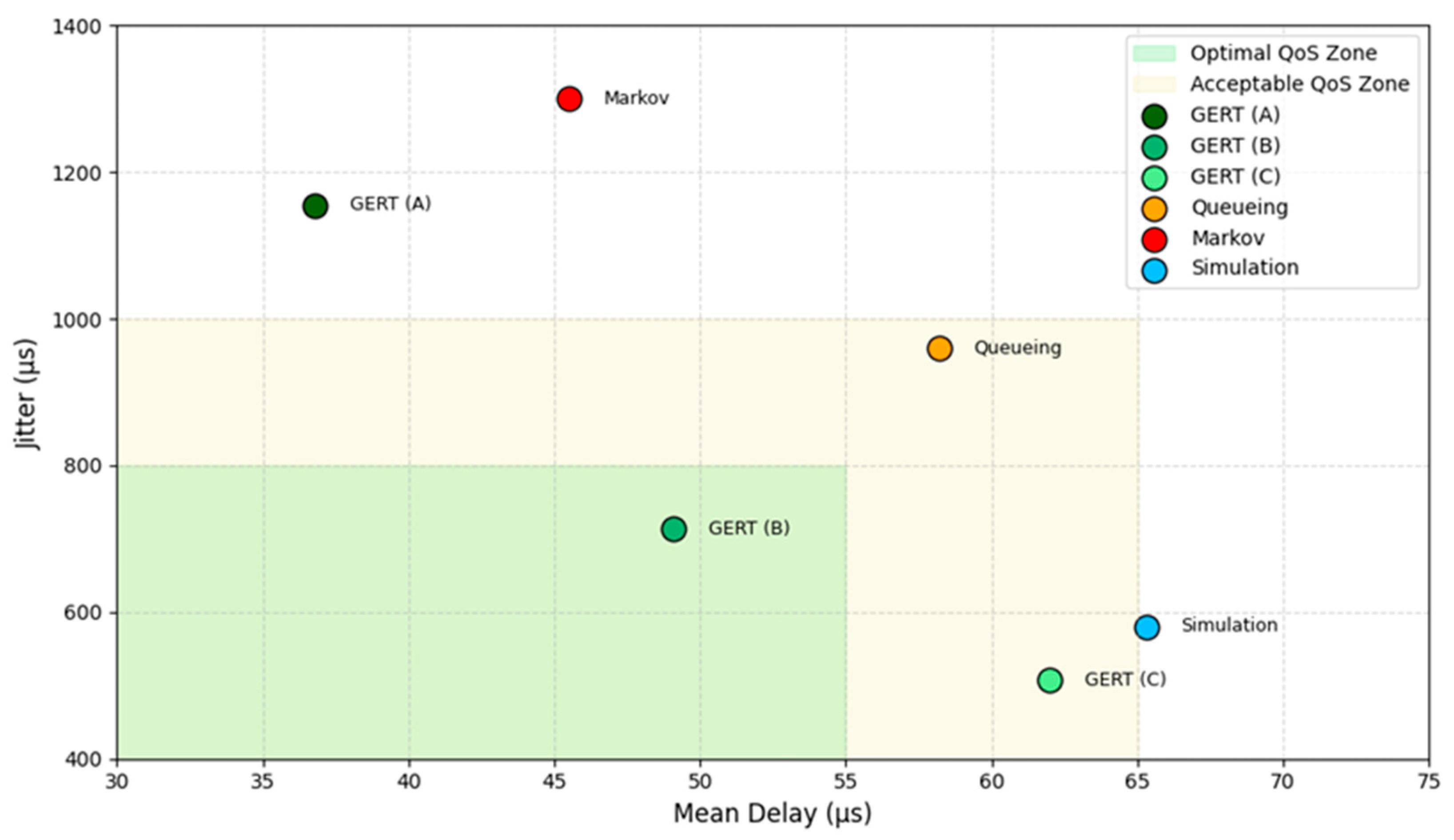
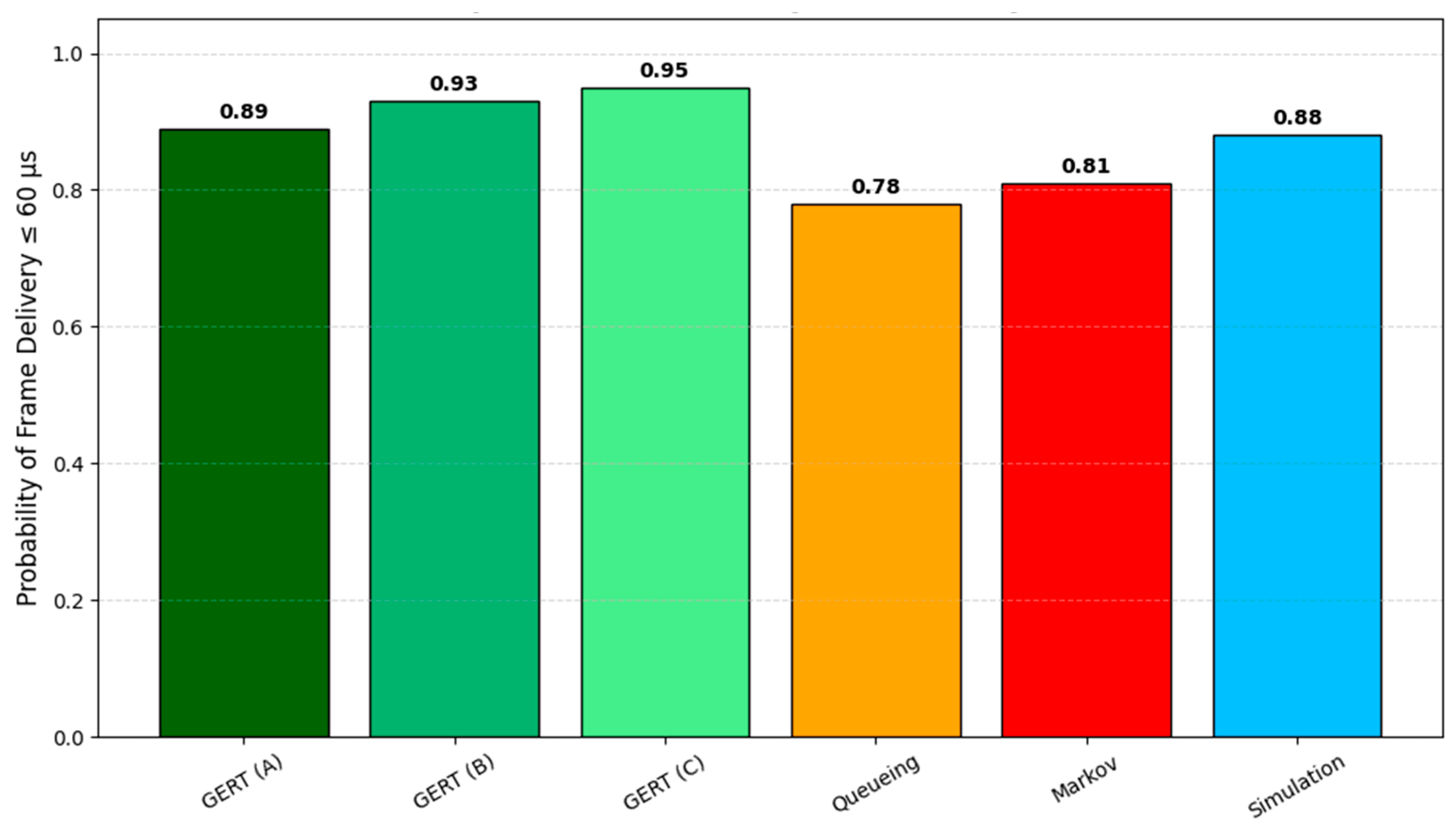
| № | Arc | Connection Type | Distribution Type | /Comment |
|---|---|---|---|---|
| 1 | v1→v2 | Sequential | Deterministic | / capture |
| 2 | v2→v3 | Sequential | Deterministic | / preprocessing |
| 3 | v3→v4 | Sequential | Triangular | Mtri(s)/ buffering |
| 4 | v4→v5 | Parallel 1 | Deterministic | / without FEC |
| 5 | v5→v6 | Sequential | Deterministic | / predicted delay |
| 6 | v6→v11 | Sequential | Deterministic | / direct transition to reception |
| 7 | v4→v9 | Parallel 2 | Deterministic | / with FEC |
| 8 | v9→v10 | Sequential | Exponential | / transmission over channel |
| 9 | v10→v11 | Sequential | Deterministic | / reception |
| 10 | v4→v7 | Parallel 3 | Deterministic | / FEC + fps |
| 11 | v7→v8 | Sequential | Deterministic | / slowed-down transmission |
| 12 | v8→v11 | Sequential | Exponential | / transmission over channel |
| 13 | v11→v12 | Sequential | Lognormal | / buffering, decoding, display |
| 14 | v11→v4 | Feedback | Stochastic | / retransmission in case of error |
| exponential for deterministic delays | |
| Mtri(s) | moment function of the triangular distribution |
| for the exponential distribution | |
| MlogN(s) | moment function of the lognormal distribution |
| Scenario | μ | σ | E[T]_Numerical (μs) | E[T]_Cutoff (μs) | E[T]_Analytic (μs) | Jitter (μs) |
|---|---|---|---|---|---|---|
| Scenario A | 3.0 | 0.7 | 19.7 | 23.9 | 36.8 | 1154.51 |
| Scenario B | 3.3 | 0.8 | 16.8 | 20.9 | 49.1 | 713.44 |
| Scenario C | 3.5 | 0.9 | 16.0 | 20.2 | 62.0 | 507.18 |
| C | Re[M(iC)] | Im[M(iC)] | Abs[M(iC)] |
|---|---|---|---|
| −1.65275 | 0.000212 | 0.000218 | 0.000304 |
| −1.55259 | 0.00038 | 7.31 × 10−05 | 0.000387 |
| −1.45242 | 0.000456 | −0.00019 | 0.000495 |
| −1.35225 | 0.000364 | −0.00053 | 0.000645 |
| −1.25209 | 4.14 × 10−05 | −0.00087 | 0.000868 |
| −1.15192 | −0.00059 | −0.00107 | 0.001224 |
| −1.05175 | −0.00161 | −0.00086 | 0.001823 |
| −0.95159 | −0.00281 | 0.000379 | 0.002835 |
| −0.85142 | −0.00303 | 0.003339 | 0.004512 |
| −0.75125 | 0.000318 | 0.007209 | 0.007216 |
| −0.65109 | 0.009127 | 0.006889 | 0.011435 |
| −0.55092 | 0.016565 | −0.00645 | 0.017775 |
| −0.45075 | −0.00159 | −0.02743 | 0.027479 |
| −0.35058 | −0.05092 | 0.008569 | 0.051633 |
| −0.25042 | 0.083323 | 0.159237 | 0.17972 |
| −0.15025 | 0.737843 | −0.65708 | 0.98801 |
| −0.05008 | −10.6359 | −2.0641 | 10.83432 |
| 0.050083 | −10.6359 | 2.064101 | 10.83432 |
| 0.15025 | 0.737843 | 0.657079 | 0.98801 |
| 0.250417 | 0.083323 | −0.15924 | 0.17972 |
| 0.350584 | −0.05092 | −0.00857 | 0.051633 |
| 0.450751 | −0.00159 | 0.027433 | 0.027479 |
| 0.550918 | 0.016565 | 0.006446 | 0.017775 |
| 0.651085 | 0.009127 | −0.00689 | 0.011435 |
| 0.751252 | 0.000318 | −0.00721 | 0.007216 |
| 0.851419 | −0.00303 | −0.00334 | 0.004512 |
| 0.951586 | −0.00281 | −0.00038 | 0.002835 |
| 1.051753 | −0.00161 | 0.000865 | 0.001823 |
| 1.15192 | −0.00059 | 0.001073 | 0.001224 |
Disclaimer/Publisher’s Note: The statements, opinions and data contained in all publications are solely those of the individual author(s) and contributor(s) and not of MDPI and/or the editor(s). MDPI and/or the editor(s) disclaim responsibility for any injury to people or property resulting from any ideas, methods, instructions or products referred to in the content. |
© 2025 by the authors. Licensee MDPI, Basel, Switzerland. This article is an open access article distributed under the terms and conditions of the Creative Commons Attribution (CC BY) license (https://creativecommons.org/licenses/by/4.0/).
Share and Cite
Semenov, S.; Krupska-Klimczak, M.; Frontczak, M.; Yu, J.; He, J.; Chernykh, O. Adaptive Stochastic GERT Modeling of UAV Video Transmission for Urban Monitoring Systems. Appl. Sci. 2025, 15, 9277. https://doi.org/10.3390/app15179277
Semenov S, Krupska-Klimczak M, Frontczak M, Yu J, He J, Chernykh O. Adaptive Stochastic GERT Modeling of UAV Video Transmission for Urban Monitoring Systems. Applied Sciences. 2025; 15(17):9277. https://doi.org/10.3390/app15179277
Chicago/Turabian StyleSemenov, Serhii, Magdalena Krupska-Klimczak, Michał Frontczak, Jian Yu, Jiang He, and Olena Chernykh. 2025. "Adaptive Stochastic GERT Modeling of UAV Video Transmission for Urban Monitoring Systems" Applied Sciences 15, no. 17: 9277. https://doi.org/10.3390/app15179277
APA StyleSemenov, S., Krupska-Klimczak, M., Frontczak, M., Yu, J., He, J., & Chernykh, O. (2025). Adaptive Stochastic GERT Modeling of UAV Video Transmission for Urban Monitoring Systems. Applied Sciences, 15(17), 9277. https://doi.org/10.3390/app15179277








